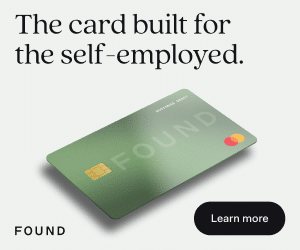94% of people form their first impressions of a website based on its design.
If you’ve ever doubted the importance of website design, I bet you don’t now.
Whether you’re a freelancer, entrepreneur, or creative, your website isn’t just a digital placeholder. It’s a powerful tool for building trust, showcasing your work, and attracting new opportunities.


Get Weekly Freelance Gigs via Email
Enter your freelancing address and we’ll send you a FREE curated list of freelance jobs in your top category every week.
In this post, we’ll look at five personal website examples to help inspire your own.
Elements Your Personal Website Should Have
If you’re thinking about creating (or revamping) your personal website, you must get a few key elements right. Your site isn’t just a digital business card. It’s a space where people can connect with you, learn about your work, and (hopefully) want to work with you.
Here’s what every great personal website should have:
- A clear introduction. Within seconds of landing on your site, visitors should know who you are and what you do. A simple tagline or a short bio on your homepage works wonders.
- A well-designed “About” page. This is your chance to tell your story! People love to connect with real humans, so make your “About” page more than just a resume—share your journey, what you’re passionate about, and maybe even a fun fact or two.
- A portfolio or work showcase. Whether you’re a designer, writer, developer, or consultant, show off your best work. Case studies, samples, or even testimonials add credibility and help people see your expertise in action.
- A way to contact you. Make it ridiculously easy for people to reach out. A simple contact form, an email address, or even links to your social media work fine—don’t make visitors hunt for this info!
- A personal touch. The best personal websites feel like you. Whether it’s through color choices, imagery, or even little snippets of personality in your copy, make sure your site represents your unique style.
- Mobile-friendly and fast. You’ll lose visitors if your site looks great on a laptop but breaks on a phone. A clean, mobile-responsive design and fast load times are non-negotiable.
5 Best Personal Websites to Inspire Yours
1. Tim Ferriss
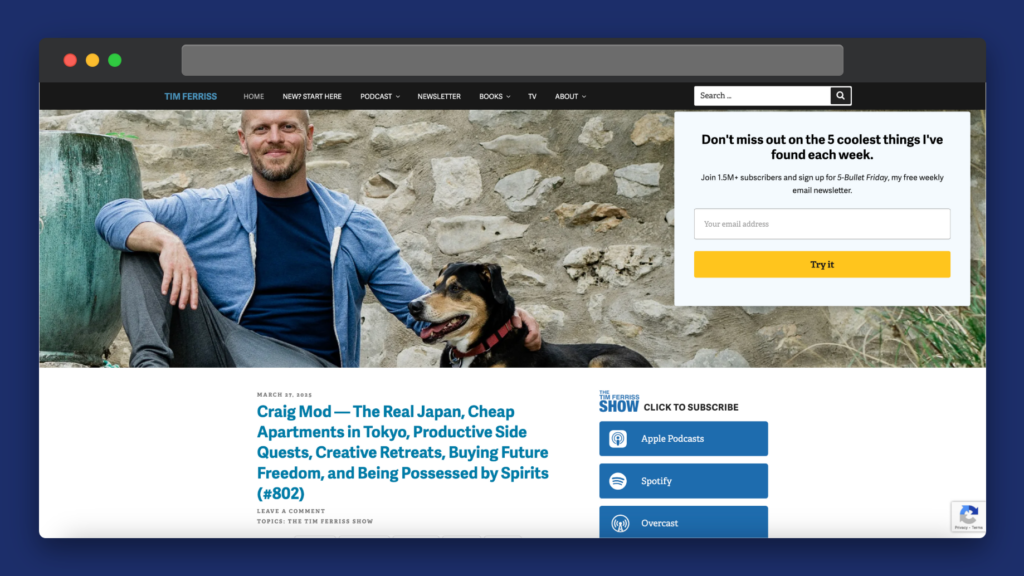

Tim Ferriss is a bestselling author, entrepreneur, and podcast host. He’s best known for The 4-Hour Workweek and his deep dives into productivity, self-improvement, and unconventional thinking.
His website is a hub for his work, featuring his popular podcast, book recommendations, and insightful blog posts. Tim’s site is an excellent example of a personal website that does it all while staying clean and easy to navigate.
What His Website Does Right:
- Content front and center. The homepage immediately pulls you into his world, featuring his blog, podcast, and books. No fluff—just valuable content right away.
- Minimalist, easy-to-navigate design. The site is simple but effective. No distractions, just clear sections for his main offerings.
- Strong personal branding. Tim’s voice and expertise shine through in every part of the site. Everything aligns with his brand, Whether through his blog posts or curated book lists.
- Trust signals and social proof. He includes media mentions, bestselling books, and guest appearances on significant platforms, instantly boosting his credibility.
- Email list call-to-action (CTA). Right at the top, there’s an option to subscribe to his newsletter, making it easy for visitors to stay connected.
Key Takeaways for Your Own Website:
✅ Keep your homepage clean and focused. Showcase your best work upfront.
✅ Make navigation effortless so visitors can find what they need quickly.
✅ Use your site to build trust by featuring testimonials, media mentions, or past work.
✅ Encourage visitors to stay connected through an email list, blog, or social links.
2. Sahara Rose
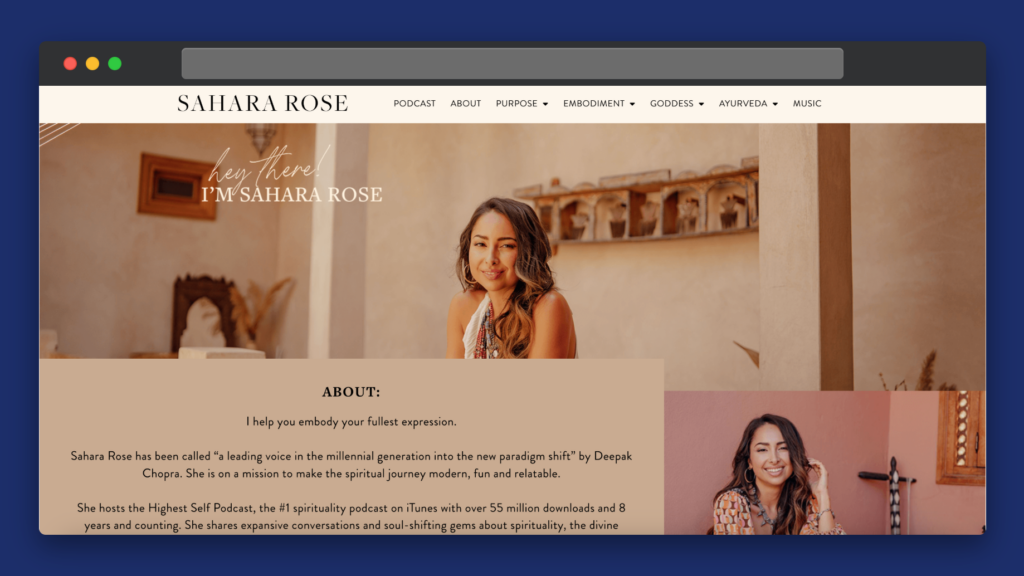

Sahara Rose is a bestselling author, podcast host, and spiritual mentor known for bringing ancient wisdom into modern life. She focuses on topics like Ayurveda, Dharma (life purpose), and self-empowerment, helping people align with their highest selves.
Her website is a beautiful reflection of her brand—vibrant, soulful, and packed with resources to guide visitors on their journey.
What Her Website Does Right:
- Bold, eye-catching visuals. The site is full of rich colors, high-quality images, and a modern design that feels warm and inviting. It’s an extension of her personal brand and energy.
- Clear personal branding. You know what she’s about from the moment you land on her homepage. Her messaging is clear: she helps people find their purpose and step into their highest potential.
- Strong call-to-actions (CTAs). Whether it’s her free Dharma Archetype Quiz, books, or programs, the site guides visitors toward engaging with her content in a meaningful way.
- A community-driven feel. Her website isn’t just about her—it’s about the people she serves. Through her courses, podcast, and community offerings, she creates a space where visitors feel seen and supported.
- Multi-platform integration. She seamlessly connects her podcast, books, and social media, making it easy for visitors to dive deeper into her work wherever they prefer.
Key Takeaways for Your Own Website:
✅ Use colors, fonts, and images that reflect your unique energy and brand.
✅ Make your website feel welcoming and aligned with the message you want to share.
✅ Guide visitors with clear CTAs—joining an email list, taking a quiz, exploring more content, etc.
✅ Build a sense of community so people feel like they belong in your space.
Sahara Rose’s website is an excellent example of how personal branding isn’t just about looking good. It’s about creating an experience that resonates with your audience.
3. Marzzacco Injury Law
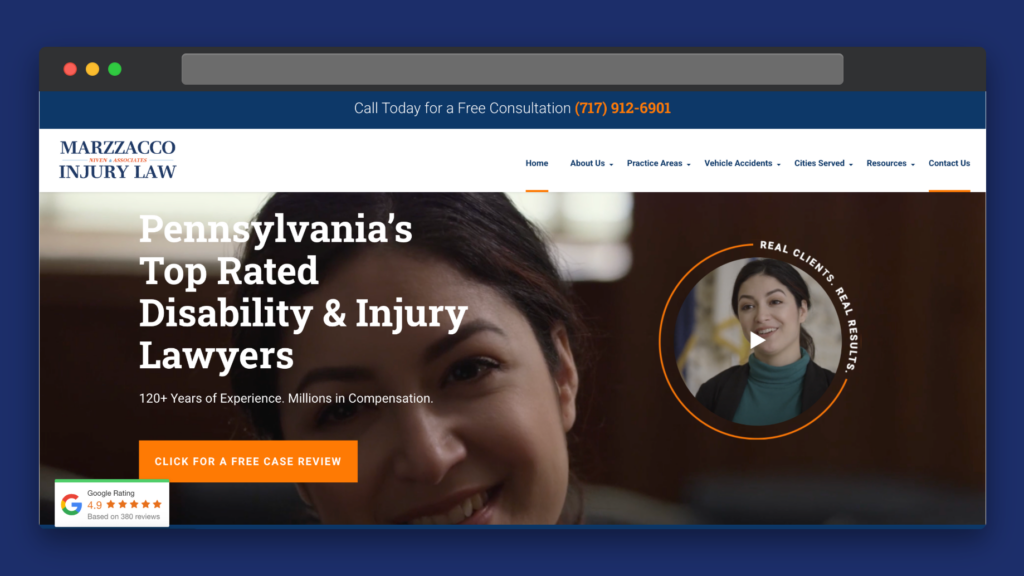

At first glance, you might think a law firm website has nothing to do with personal branding. But Marzzacco Injury Law’s website is a great example for entrepreneurs and solopreneurs—whether you’re a lawyer or not. It’s clean, professional, and designed to build trust and convert visitors into clients.
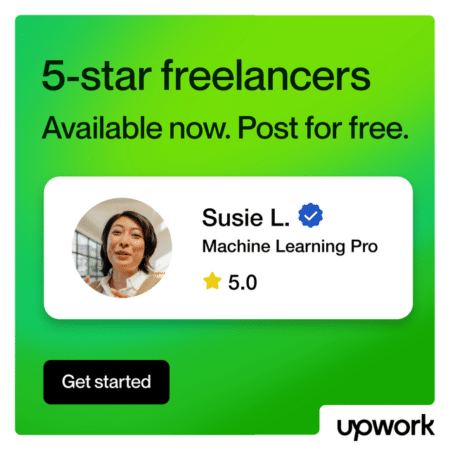

What Their Website Does Right:
- Crystal clear messaging. The site immediately tells visitors what Marzzacco Injury Law does: They help injured people get justice. There’s no jargon, no fluff. Just clear, client-focused messaging.
- Strong calls-to-action (CTAs). Every page makes it easy for potential clients to take the next step, whether that’s scheduling a consultation or calling the firm.
- Credibility and trust signals. Trust is everything in legal services (or any business, really). The site features client testimonials, case results, and recognitions to reassure visitors they’re in good hands.
- Mobile-friendly and fast. – Since many people look for legal help on their phones, the site is optimized for mobile, making it easy to navigate on any device.
- Professional yet personable. While it maintains a polished legal look, the website doesn’t feel cold or robotic. It includes actual photos of attorneys, clear contact options, and approachable language.
Another common theme you’ll see on professional, high-quality personal websites? They’re full of resources.
Marzzacco has a very regularly updated blog that answers their target audience’s biggest legal questions for free. It also helps their content marketing strategy by bringing them organic search traffic from Google.
You’ll also see this on websites like Malone Law and the Baumgartner Law Firm.
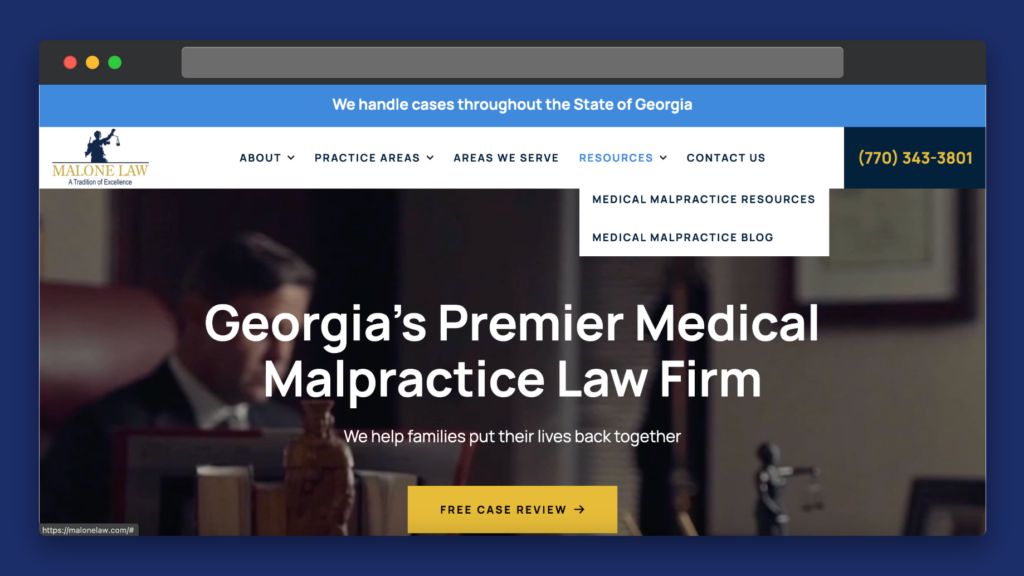

Key Takeaways for Your Own Website:
✅Clarity is everything. Make sure visitors instantly understand what you offer.
✅Guide visitors toward action. Whether that’s booking a call, signing up, or contacting you.
✅Showcase credibility. Testimonials, success stories, or certifications build trust.
✅Provide high-value content and free resources to educate your potential clients/customers.
✅Make it mobile-friendly. Most people will check your site from their phones.
✅Balance professionalism with personality. People want to connect with you, not just a brand.


4. Travel Like a Bawse


If you’ve ever dreamed of ditching the 9-to-5 and traveling the world, Travel Like a Bawse is the website that will make you want to book a flight—immediately. Created by Shakeemah Smith, a full-time traveler and digital nomad, this site is packed with travel tips, remote work advice, and insider guides to making the most of life on the road.
Travel Like a Bawse is a masterclass in blending personality, value, and business into one engaging website. Whether you’re a travel blogger, content creator, or solopreneur, this site proves that your brand can be fun, informative, and profitable all at once.
What Her Website Does Right:
- Clear value proposition. From the moment you land on the homepage, you know exactly what this site is about: helping people travel smarter, work remotely, and live on their own terms.
- Super actionable content. Travel Like a Bawse isn’t just about inspiration. It’s packed with helpful content, such as free masterclasses, online courses, coaching packages, and more.
- Strong personality. Shakeemah’s personality shines through in every post, making the site feel like you’re getting advice from a well-traveled friend.
- Monetization done right. The site integrates affiliate links, courses, and travel resources in a natural, not salesy way.
Key Takeaways for Your Own Website:
✅Make your brand stand out. From your site name to your visuals, lean into what makes you unique.
✅Be clear about your value. Tell visitors exactly how you can help them right away.
✅Offer actionable content. Whether it’s tips, guides, or resources, make your site valuable.
✅Showcase your personality. Let people connect with you, not just your content.
✅Monetize strategically. Ads, affiliates, or courses should feel like a natural extension of your brand.
5. Tobias Becs
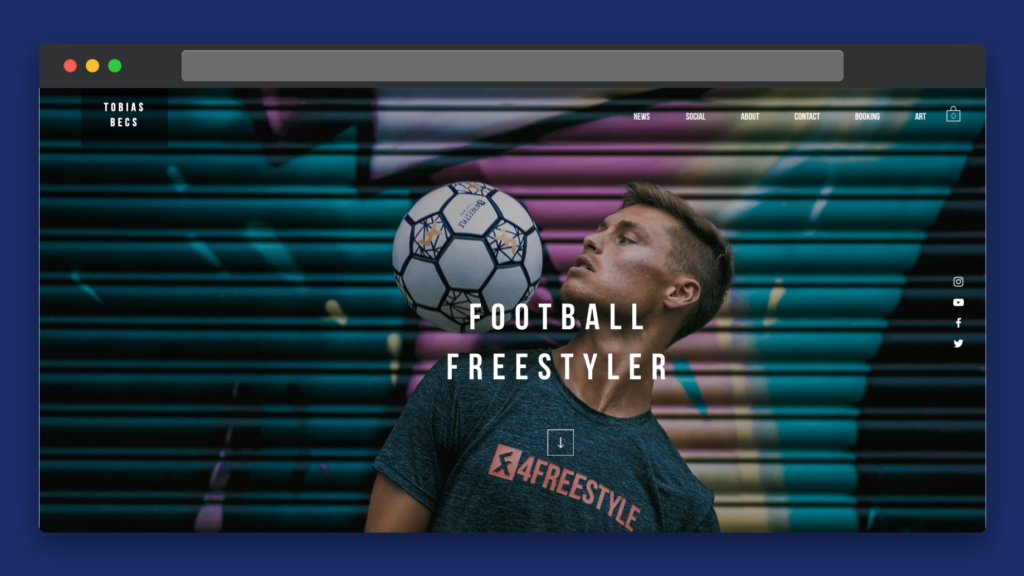

Tobias Becs is a world-class freestyle footballer, entrepreneur, and content creator. His website is a fantastic example of showcasing a personal brand with style, energy, and purpose. Whether you’re an athlete, creative, or entrepreneur, there’s much to learn from how Tobias presents himself online.
What His Website Does Right:


- Seamless social media integration. Since a huge part of his brand exists on platforms like YouTube and Instagram, his website smartly directs visitors to his social channels, where they can see his skills in action.
- Strong business and monetization strategy. His site isn’t just about showcasing his talent—it’s a business hub. It promotes his workshops, consulting services, brand collaborations, and more, showing how personal websites can be more than just a portfolio.
- Uses video. Video marketing is becoming increasingly more critical, and Tobias makes good use of it throughout his website.
Key Takeaways for Your Own Website:
- Integrate social media smartly. If your audience is on Instagram, YouTube, or TikTok, make it easy for them to connect with you there.
- Turn your site into a business tool. Whether through courses, collaborations, or services, make your website work for you.
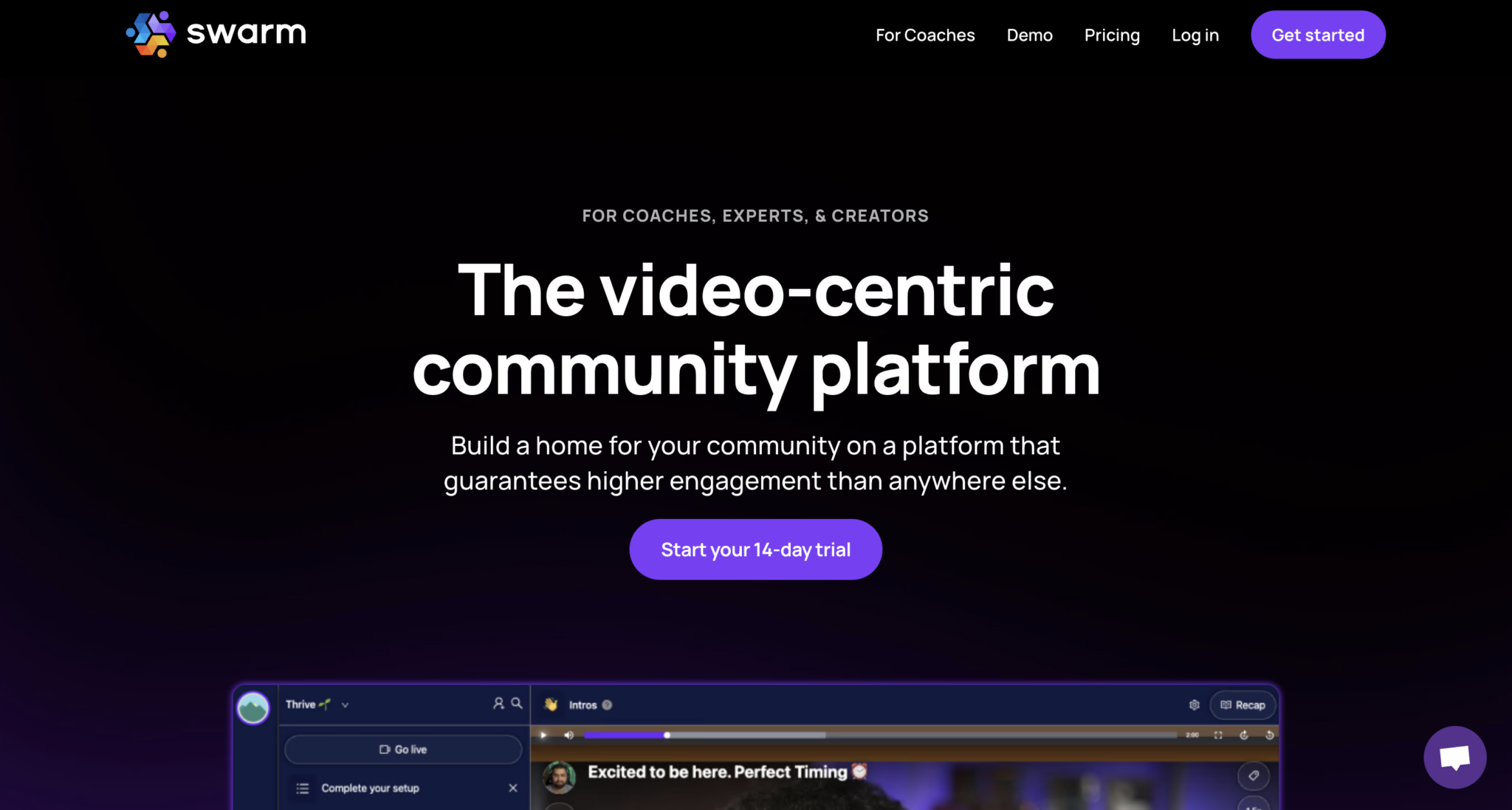

- Use videos. I recommend Swarm to make this process easier. Swarm lets you host live Q&A sessions, product demonstrations, and community discussions, making your brand feel more personal and engaging.
Conclusion
The best thing about personal websites is just that—they’re personal. You have so much creative freedom when designing. Learning from the best can inspire your own creativity and set your site up for success.
Keep the conversation going…
Over 10,000 of us are having daily conversations over in our free Facebook group and we’d love to see you there. Join us!










